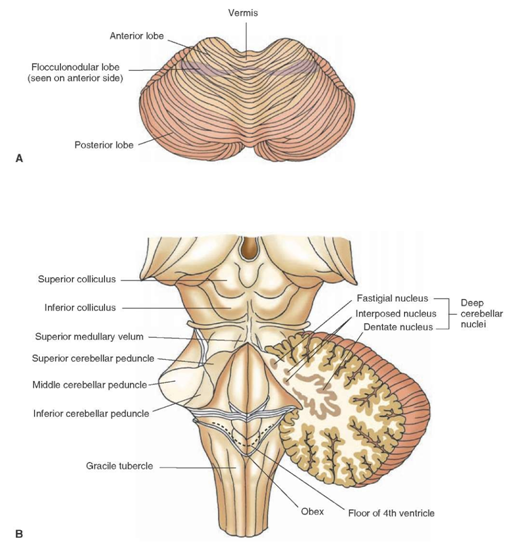
 *
*The cerebellum is a solid large structure attached to each side of the pons and separated from the dorsal surface of the pons by the fourth ventricle. The cerebellar cortex is deeply grooved and appears as thin, transverse leaves called folia which run horizontally from one side to the other. While left and right hemispheres are recognised, they form a continuous solid structure, joined in the mid-line by the vermis.. The cerebellum has several lobes. The posterior lobe developed greatly when humans evolved and adopted the upright posture; at the same time the forebrain expanded and there are important connections between these two. The older parts of the cerebellum include the flocculonodular lobe, which has connections with the vestibular apparatus and is particularly concerned with balance and eye movements. The cerebellum is concerned with the control of movement, integrating signals from different parts of the nervous system and generating error signals that allow adjustments to be made to achieve the desired objective of the movement. In cerebellar disease, voluntary movements can become grossly exaggereated and attempts to correct them result in a tremor that occurs during voluntary movement. Abnormal eye movements, nystagmus, can also appear in cerebellar disease. |
|
The cerebellum is divided into two hemispheres, one on either side of a central region called the vermis. The cerebellar cortex is deeply grooved and appears as thin, transverse leaves called folia which run horizontally from one side to the other. The left and right hemispheres form a continuous solid structure, joined in the mid-line by the vermis.. The cerebellum has can be divided into several lobes. The posterior lobe developed greatly when humans evolved and adopted the upright posture; at the same time the forebrain expanded and there are important connections between these two. The older parts of the cerebellum include the flocculonodular lobe, which has connections with the vestibular apparatus and is particularly concerned with balance and eye movements. The cerebellum arches over the pons from which it is separated by the fourth ventricle. Connections between the brain and the cerebellum pass through the cerebellar peduncles, which are sometimes divided into 3 sections: the inferior, middle and superior cerebellar peduncles. |
|
| More on the Cerebellar Pathways | Deep Cerebellar Nuclei Cerebellar Peduncles Overview of Cortico-Cerebellar Circuitry The Red Nucleus and its projections The Olive and its connections |


 *
* 